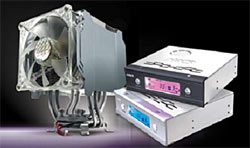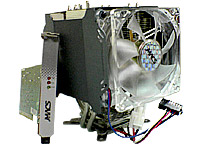Monsoon II Lite: Thermal Electric Cooling Tower
by Wesley Fink on February 6, 2007 6:00 AM EST- Posted in
- Cases/Cooling/PSUs
The heatpipe tower cooler is proving to be the most effective type of air cooler you can buy in today's market. This was clearly demonstrated in the AnandTech review of the Tuniq Tower and the recent review of two low-cost cooling towers. But like all air and water coolers, the heatpipe tower cannot cool lower than the ambient temperatures of the system. If your room is 21C, then that is the lowest possible temperature you can achieve with air or water cooling. Fortunately that is normally more than enough cooling for most overclocking, but some want to carry overclocking even further. To achieve sub-ambient temperatures, phase-change is often used, which can often cool processors to sub-zero temperatures. Phase-change is effective, but it is very expensive compared to air or water cooling and the phase-change system is extremely bulky - often much larger than the entire computer in the case.
Another sub-ambient cooling solution is TEC (Thermal Electric Cooling), which is also called Peltier cooling. For those who enjoy trivia Peltier cooling was named for the French discoverer Jean Charles Athanase Peltier. It is similar in concept to phase-change, but the TEC can in theory be much quieter and more compact, since the compressor used in phase-change cooling is not required. What is required with TEC is some means of heat dissipation. The Peltier cooler reaches sub-ambient temperatures on the cold plate, but the heat on the hot side has to be removed for the cooler to continue to work effectively. That is where efficient heat removal becomes important.

Vigor Gaming has produced cases and coolers that combine TEC and effective cooling. The Monsoon II was first introduced last year, and it represents the second generation of the Monsoon Cooler. It combines a two-phase TEC (on, half-on, off) with a fin tower and heatpipe cooler. The TEC/Cooler is controlled by a 5.25" bay mounted LCD controller that monitors and controls the processor temperature. The complete Monsoon II package has a street price of about $150.

The Lite version of the Monsoon II is being introduced this week. It uses the same TEC/Cooler as the more expensive Monsoon II, but substitutes a PCI card for the LED controller. The advantage is price, as the new Lite version will list for around $100, and the street price is expected to be in the $89 range. Lite does not mean performance is compromised in any way, as the TEC cooler is exactly the same as the more expensive Monsoon II.
The idea of a combining a TEC running at low power with an effective heatsink tower cooler is intriguing, to say the least. Vigor claims that their method of running lower power to the TEC and turning the element on, on half power, and off as dictated by temperature monitoring is much more effective than the more normal method of TEC cooling, which is always on. They also claim their monitoring method and intermittent operation virtually eliminates concerns about condensation on the cold plate side of the TEC.
These are interesting claims, but they are not easily explored in a cooler review. Instead we will concentrate on the most obvious question raised by this technology, and that is does it work as claimed? Does the Monsoon II Lite cool better than the top air towers like the Tuniq Tower 120? Is noise well controlled or are there penalties in using this cooling method? That's what we aim to find out.
Another sub-ambient cooling solution is TEC (Thermal Electric Cooling), which is also called Peltier cooling. For those who enjoy trivia Peltier cooling was named for the French discoverer Jean Charles Athanase Peltier. It is similar in concept to phase-change, but the TEC can in theory be much quieter and more compact, since the compressor used in phase-change cooling is not required. What is required with TEC is some means of heat dissipation. The Peltier cooler reaches sub-ambient temperatures on the cold plate, but the heat on the hot side has to be removed for the cooler to continue to work effectively. That is where efficient heat removal becomes important.

Vigor Gaming has produced cases and coolers that combine TEC and effective cooling. The Monsoon II was first introduced last year, and it represents the second generation of the Monsoon Cooler. It combines a two-phase TEC (on, half-on, off) with a fin tower and heatpipe cooler. The TEC/Cooler is controlled by a 5.25" bay mounted LCD controller that monitors and controls the processor temperature. The complete Monsoon II package has a street price of about $150.

The Lite version of the Monsoon II is being introduced this week. It uses the same TEC/Cooler as the more expensive Monsoon II, but substitutes a PCI card for the LED controller. The advantage is price, as the new Lite version will list for around $100, and the street price is expected to be in the $89 range. Lite does not mean performance is compromised in any way, as the TEC cooler is exactly the same as the more expensive Monsoon II.
The idea of a combining a TEC running at low power with an effective heatsink tower cooler is intriguing, to say the least. Vigor claims that their method of running lower power to the TEC and turning the element on, on half power, and off as dictated by temperature monitoring is much more effective than the more normal method of TEC cooling, which is always on. They also claim their monitoring method and intermittent operation virtually eliminates concerns about condensation on the cold plate side of the TEC.
These are interesting claims, but they are not easily explored in a cooler review. Instead we will concentrate on the most obvious question raised by this technology, and that is does it work as claimed? Does the Monsoon II Lite cool better than the top air towers like the Tuniq Tower 120? Is noise well controlled or are there penalties in using this cooling method? That's what we aim to find out.










19 Comments
View All Comments
nickfd - Tuesday, February 6, 2007 - link
Can you post a review/link to review for this cooler?Wesley Fink - Tuesday, February 6, 2007 - link
The Freezone is in our testing calendar and it will definitely be compared to the Monsoon II Lite.jvuser - Tuesday, February 6, 2007 - link
It is not recommended to run TEC/peltiers by thermostatic switching. This leads to excessive stresses and preliminary failure. See datasheets at www.marlow.com.DrMrLordX - Tuesday, February 6, 2007 - link
Reviews I've seen of the original Vigor Monsoon II seem to reflect your findings, except:1). The Monsoon II works much better when modded to work with a better 92mm fan (not easy to do)
2). The Monsoon II works better in cases with good airflow
You didn't mention the case or case fans used, and you barely showed a picture of the test system. Could you please elabourate on the airflow situation in which you tested the Monsoon II? Also, are you able to include a Titan Amanda in your test as well?
It is good that the Monsoon II will now be available at a lower price.
RobFDB - Tuesday, February 6, 2007 - link
From your results the only advantage the Monsoon II Lite seems to give the EU is maybe 60 more mhz. Aside from that it costs more than the Tuniq 120, it doesn't cool as well, it adds 50w of power to your overall consumption and it's noisier. Sure it's an innovative idea, but it doesn't actually help out the EU.Jodiuh - Tuesday, February 6, 2007 - link
Exactly what I wanted to say. I'm one of those "will give up OC for a nice quiet room" guys. And I actually replaced the Tuniq fan w/ a Scythe SFLEX. :DSurJector - Tuesday, February 6, 2007 - link
I totally agree as well. Additionally the sentenceis incorrect: the air cooler has to cool 49 more W. If the processor consumes 150W and the Peltier element 49W (leaving 1W for the fan), then the radiator has 199W to cool down instead of 150W. It is very tricky to cool down a Peltier element without noise. In that case, I would say that they did not succeed: the processor is warmer and the fan noisier. The additional 60MHz (i.e. 1.5%) look insignificant, at least to me.
Wesley Fink - Tuesday, February 6, 2007 - link
The noise level with the TEC and fan running at full speed is still much lower than the stress sound levels we measured. Most of the added noise is the buzzing, pops, and clicks from the fan being controlled simultaneously with the TEC. As we said in the review the fan running continously is much quieter.Vigor says they are aware of the issues and they are working to separately control the fan and TEC with the controller. This will definitely reduce noise levels.
DigitalFreak - Tuesday, February 6, 2007 - link
I totally agree. While it's a novel idea, the only plus it has over the Tuniq 120 is an extra 60Mhz overclock. When I get my C2D or C2Q system, I'm going with the Tuniq.